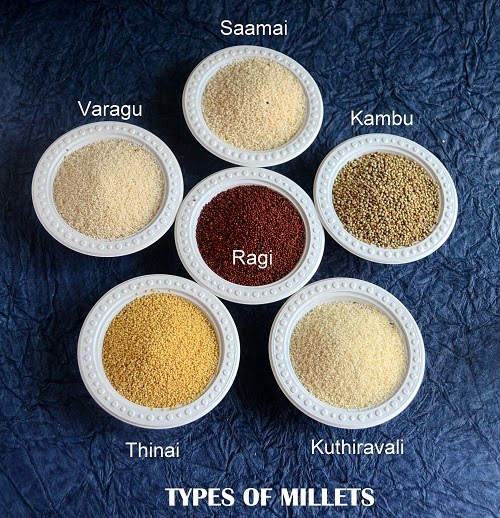What are millets?
Millet is tiny in size and round in shape and can be white, gray, yellow or red. The most widely available form of millet found in stores is the hulled variety, although traditional couscous made from cracked millet can also be found. The majority of the world’s commercial millet crop is produced by India, China and Nigeria.
It is a delicious grain whose consistency varies depending upon cooking method; it can be creamy like mashed potatoes or fluffy like rice. Additionally, since millet does not contain gluten, it is a wonderful grain alternative for people who are gluten-sensitive.
Pearl millet known as Kambu in Tamil has 8 times more iron than rice does. It is a great body coolant.
Finger millet popularly known as Ragi is also called as wonder grain as it is a powerhouse of essential amino acids and calcium.
Foxtail millet is thinai in Tamil. This is high in carbohydrate but also rich in fiber.It helps us to keep our body strong & immune. It helps to control blood sugar & cholesterol levels.
Kodo millet is known as varagu in Tamil. It is rich in phytochemicals, that plays an important role in preventing cancer. Barnyard millet known as kuthiravali has 6 times more fiber in comparison to wheat.
Little millet known as saamai is a wonderful millet which is suitable for people of all ages and can be incorporated in different dishes.
How to Select and Store
Millet is generally available in its hulled and whole-grain form. It is available pre-packed as well as in bulk containers. Just as with any other food that you may purchase in the bulk section, make sure that the bins containing the millet are covered and that the store has a good product turnover so as to ensure its maximal freshness. Whether purchasing millet in bulk or in a packaged container, make sure that there is no evidence of moisture.
Store millet in an airtight container in a cool, dry and dark place, where it will keep for several months.
Tips for Preparing and Cooking
The Healthiest Way of Cooking Millet
Like all grains, before cooking millet rinse it thoroughly under running water and then remove any dirt or debris that you may find. After rinsing, add one part millet to two and a half parts boiling water or broth. After the liquid has returned to a boil, turn down the heat, cover and simmer for about 25 minutes or it can also be pressure cooked. The texture of millet cooked this way will be fluffy like rice. If you want the millet to have a more creamy consistency, stir it frequently adding a little water every now and then.
To impart a nuttier flavour to the cooked millet, you could roast the grains before boiling them. To do this, place the grains in a dry skillet over medium heat and stir them frequently. When they have achieved a golden colour, add them to the boiling cooking liquid.
Health benefits
- Millet acts as a prebiotic feeding microflora in the inner ecosystem.
- The serotonin derived from millet is calming to moods and brings good sleep.
- Millet is a small carbohydrate food with lots of fiber and low simple sugars. Because of this it has a relatively low glycemic index and has been shown to produce lower blood sugar levels than wheat or rice.
- Niacin (vitamin B3) in millet can help lower cholesterol.
- Millet is gluten-free and non-allergenic; a great grain for individuals with celiac disease and gluten sensitivity.
- Millet’s high protein content (15 percent) makes it a substantial addition to a vegetarian
- Millets are generally rich in Protein, Fibre, Calcium, Iron and Minerals especially Magnesium, Copper and Phosphorous.
- It helps to lower the risk of Type 2 Diabetes.
- It is high insoluble fiber content protects against Gallstones.
- Phytonutrients in millets, particularly lignan, helps reduce the risk of breast and colon cancer.
Regularly adding millets to our diet is a great way to prevent heart and blood vessel disorders.





